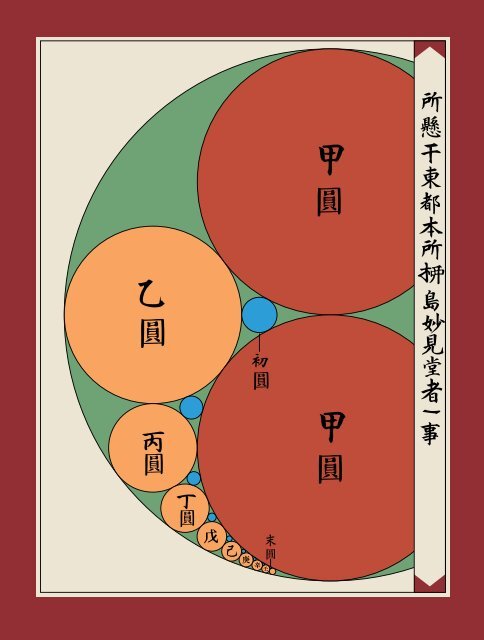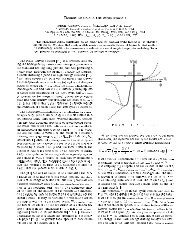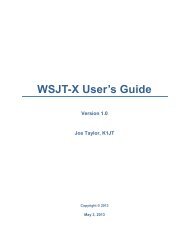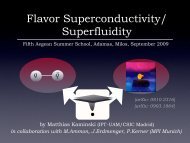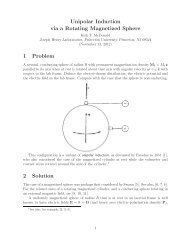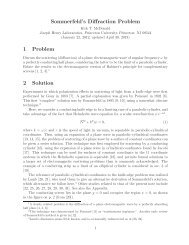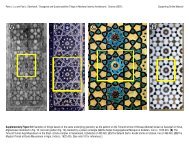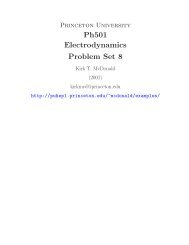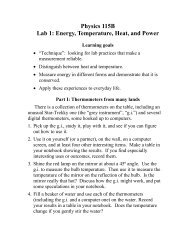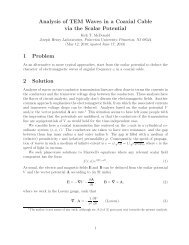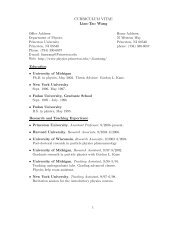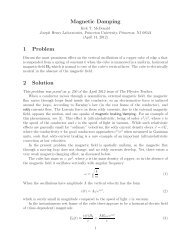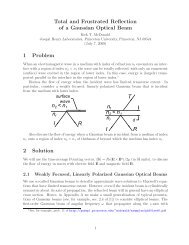Japanese Temple Geometry
Japanese Temple Geometry
Japanese Temple Geometry
You also want an ePaper? Increase the reach of your titles
YUMPU automatically turns print PDFs into web optimized ePapers that Google loves.
<strong>Japanese</strong> <strong>Temple</strong> <strong>Geometry</strong><br />
During Japan’s period of national seclusion (1639–1854), native<br />
mathematics thrived, as evidenced in sangaku—wooden tablets engraved<br />
with geometry problems hung under the roofs of shrines and temples<br />
by Tony Rothman, with the cooperation of Hidetoshi Fukagawa<br />
BRYAN CHRISTIE, AFTER TOSHIHISA IWASAKI<br />
Of the world’s countless customs<br />
and traditions, perhaps<br />
none is as elegant, nor as<br />
beautiful, as the tradition of sangaku,<br />
<strong>Japanese</strong> temple geometry. From 1639<br />
to 1854, Japan lived in strict, self-imposed<br />
isolation from the West. Access<br />
to all forms of occidental culture was<br />
suppressed, and the influx of Western<br />
scientific ideas was effectively curtailed.<br />
During this period of seclusion, a kind<br />
of native mathematics flourished.<br />
Devotees of math, evidently samurai,<br />
merchants and farmers, would solve a<br />
wide variety of geometry problems, inscribe<br />
their efforts in delicately colored<br />
wooden tablets and hang the works under<br />
the roofs of religious buildings. These<br />
sangaku, a word that literally means<br />
mathematical tablet, may have been acts<br />
of homage—a thanks to a guiding spirit—<br />
or they may have been brazen challenges<br />
to other worshipers: Solve this one if<br />
you can!<br />
For the most part, sangaku deal with<br />
ordinary Euclidean geometry. But the<br />
problems are strikingly different from<br />
those found in a typical high school geometry<br />
course. Circles and ellipses play<br />
a far more prominent role than in Western<br />
problems: circles within ellipses, ellipses<br />
within circles. Some of the exercises<br />
are quite simple and could be solved<br />
by first-year students. Others are nearly<br />
impossible, and modern geometers invariably<br />
tackle them with advanced<br />
methods, including calculus and affine<br />
transformations. Although most of the<br />
problems would be classified today as<br />
recreational or educational mathematics,<br />
a few predate known Western results,<br />
such as the Malfatti theorem, the<br />
Casey theorem and the Soddy hexlet<br />
theorem. One problem reproduces the<br />
Descartes circle theorem. Many of the<br />
tablets are exceptionally beautiful and<br />
can be regarded as works of art.<br />
Pleasing the Kami<br />
It is natural to wonder who created<br />
the sangaku and when, but it is easier<br />
to ask such questions than to answer<br />
them. The custom of hanging tablets at<br />
shrines was established in Japan centuries<br />
before sangaku came into existence.<br />
Shintoism, Japan’s native religion,<br />
is populated by “eight hundred myriads<br />
of gods,” the kami. Because the kami, it<br />
was said, love horses, those worshipers<br />
who could not present a living horse as<br />
an offering to the shrine might instead<br />
give a likeness drawn on wood. As a result,<br />
many tablets dating from the 15th<br />
century and earlier depict horses.<br />
Of the sangaku themselves, the oldest<br />
surviving tablet has been found in Tochigi<br />
Prefecture and dates from 1683.<br />
Another tablet, from Kyoto, is dated<br />
1686, and a third is from 1691. The<br />
19th-century travel diary of the mathematician<br />
Kazu Yamaguchi refers to an<br />
even earlier tablet—now lost—dated<br />
1668. So historians guess that the custom<br />
first arose in the second half of the<br />
17th century. In 1789 the first collection<br />
containing typical sangaku problems<br />
was published. Other collections<br />
SANGAKU PROBLEMS typically involve multitudes of circles within circles or of<br />
spheres within other figures. This problem is from a sangaku, or mathematical wooden<br />
tablet, dated 1788 in Tokyo Prefecture. It asks for the radius of the nth largest blue<br />
circle in terms of r, the radius of the green circle. Note that the red circles are identical,<br />
each with radius r/2. (Hint: The radius of the fifth blue circle is r/95.) The original solution<br />
to this problem deploys the <strong>Japanese</strong> equivalent of the Descartes circle theorem.<br />
(The answer can be found on page 91.)<br />
followed throughout the 18th and 19th<br />
centuries. These books were either handwritten<br />
or printed with wooden blocks<br />
and are remarkably beautiful. Today<br />
more than 880 tablets survive, with references<br />
to hundreds of others in the<br />
various collections. From a survey of<br />
the extant sangaku, the tablets seem to<br />
have been distributed fairly uniformly<br />
throughout Japan, in both rural and urban<br />
districts, with about twice as many<br />
found in Shinto shrines as in Buddhist<br />
temples.<br />
Most of the surviving sangaku contain<br />
more than one theorem and are frequently<br />
brightly colored. The proof of<br />
the theorem is usually not given, only<br />
the result. Other information typically<br />
includes the name of the presenter and<br />
the date. Not all the problems deal solely<br />
with geometry. Some ask for the volumes<br />
of various solids and thus require<br />
calculus. (This point raises the interesting<br />
question of what techniques the<br />
practitioners brought into play; some<br />
speculations will be offered in the following<br />
discussion.) Other tablets contain<br />
Diophantine problems—that is, algebraic<br />
equations requiring solutions in<br />
integers.<br />
In modern times the sangaku have<br />
been largely forgotten but for a few<br />
devotees of traditional <strong>Japanese</strong> mathematics.<br />
Among them is Hidetoshi Fukagawa,<br />
a high school teacher in Aichi<br />
Prefecture, roughly halfway between<br />
Tokyo and Osaka. About 30 years ago<br />
Fukagawa decided to study the history<br />
of <strong>Japanese</strong> mathematics in hopes of<br />
finding better ways to teach his courses.<br />
A mention of the math tablets in an old<br />
library book greatly astonished him, for<br />
he had never heard of such a thing. Since<br />
then, Fukagawa, who holds a Ph.D. in<br />
mathematics, has traveled widely in Japan<br />
to study the tablets and has amassed<br />
a collection of books dealing not only<br />
<strong>Japanese</strong> <strong>Temple</strong> <strong>Geometry</strong> Scientific American May 1998 85
Typical Sangaku Problems*<br />
Here is a simple problem that has survived on an 1824<br />
tablet in Gumma Prefecture. The orange and blue circles<br />
touch each other at one point and are tangent to the<br />
same line. The small red circle touches both of the larger<br />
circles and is also tangent to the same line. How are the<br />
radii of the three circles related?<br />
This striking problem was written in 1912 on a tablet extant in<br />
Miyagi Prefecture; the date of the problem itself is unknown.<br />
At a point P on an ellipse, draw the normal PQ such that it intersects<br />
the other side. Find the least value of PQ. At first<br />
glance, the problem appears to be trivial: the minimum PQ<br />
is the minor axis of the ellipse. Indeed, this is the solution if<br />
b < a ≤ √2b, where a and b are the major and minor axes,<br />
respectively; however, the tablet does not give this solution<br />
but another, if 2b 2 < a 2 .<br />
P<br />
Q<br />
This beautiful problem, which requires no more than<br />
high school geometry to solve, is written on a<br />
tablet dated 1913 in Miyagi Prefecture. Three<br />
orange squares are drawn as shown in<br />
the large, green right triangle. How<br />
are the radii of the three blue<br />
circles related?<br />
BRYAN CHRISTIE<br />
86 Scientific American May 1998<br />
<strong>Japanese</strong> <strong>Temple</strong> <strong>Geometry</strong>
In this problem, from an 1803 sangaku<br />
found in Gumma Prefecture, the<br />
base of an isosceles triangle sits on a<br />
diameter of the large green circle.<br />
This diameter also bisects the red circle,<br />
which is inscribed so that it just<br />
touches the inside of the green circle<br />
and one vertex of the triangle, as<br />
shown. The blue circle is inscribed so<br />
that it touches the outsides of both<br />
the red circle and the triangle, as well<br />
as the inside of the green circle. A line<br />
segment connects the center of the<br />
blue circle and the intersection point<br />
between the red circle and the triangle.<br />
Show that this line segment is<br />
perpendicular to the drawn diameter<br />
of the green circle.<br />
This problem comes from an 1874<br />
tablet in Gumma Prefecture. A large<br />
blue circle lies within a square. Four<br />
smaller orange circles, each with a<br />
different radius, touch the blue circle<br />
as well as the adjacent sides of the<br />
square. What is the relation between<br />
the radii of the four small circles and<br />
the length of the side of the square?<br />
(Hint: The problem can be solved by<br />
applying the Casey theorem, which<br />
describes the relation between four<br />
circles that are tangent to a fifth circle<br />
or to a straight line.)<br />
* Answers are on<br />
page 91.<br />
with sangaku but with the general field<br />
of traditional <strong>Japanese</strong> mathematics.<br />
To carry out his research, Fukagawa<br />
had to teach himself Kambun, an archaic<br />
form of <strong>Japanese</strong> that is closely related<br />
to Chinese. Kambun is the <strong>Japanese</strong><br />
equivalent of Latin; during the Edo period<br />
(1603–1867), scientific works were<br />
written in this language, and only a few<br />
people in modern Japan are able to read<br />
it fluently. As new tablets have been discovered,<br />
Fukagawa has been called in<br />
to decipher them. In 1989 Fukagawa,<br />
along with Daniel Pedoe, published the<br />
first collection of sangaku in English.<br />
Most of the geometry problems accompanying<br />
this article were drawn from<br />
that collection.<br />
Wasan versus Yosan<br />
Although the origin of the sangaku<br />
cannot be pinpointed, it can be localized.<br />
There is a word in <strong>Japanese</strong>,<br />
wasan, that is used to refer to native<br />
<strong>Japanese</strong> mathematics. Wasan is meant<br />
to stand in opposition to yosan, or<br />
Western mathematics. To understand<br />
how wasan came into existence—and<br />
with it the unusual sangaku problems—<br />
one must first appreciate the peculiar<br />
history of <strong>Japanese</strong> mathematics.<br />
Of the earliest times, very little is definitely<br />
known about mathematics in Japan,<br />
except that a system of exponential<br />
notation, similar to that employed<br />
by Archimedes in the Sand Reckoner,<br />
had been developed. More concrete information<br />
dates only from the mid-sixth<br />
century A.D., when Buddhism—and,<br />
with it, Chinese mathematics—made its<br />
way to Japan. Judging from the works<br />
that were taught at official schools at<br />
the start of the eighth century, historians<br />
infer that Japan had imported the<br />
great Chinese classics on arithmetic, algebra<br />
and geometry.<br />
According to tradition, the earliest of<br />
these is the Chou-pei Suan-ching, which<br />
contains an example of the Pythagorean<br />
theorem and the diagram commonly<br />
used to prove it. This part of the tome<br />
is at least as old as the sixth century B.C.<br />
A more advanced state of knowledge<br />
is represented in the Chiu-chang Suanshu,<br />
considered the most influential of<br />
Chinese books on mathematics. The<br />
Chiu-chang describes methods for finding<br />
the areas of triangles, quadrilaterals,<br />
circles and other figures. It also contains<br />
simple word problems of the type<br />
that torment many high school students<br />
today: “If five oxen and two sheep cost<br />
eight taels of gold, and two oxen and<br />
eight sheep cost eight taels, what is the<br />
price of each animal?” The dates of the<br />
Chiu-chang are also uncertain, but most<br />
of it was probably composed by the<br />
third century B.C. If this information is<br />
correct, the Chiu-chang contains perhaps<br />
the first known mention of negative<br />
numbers and an early statement of<br />
the quadratic equation. (According to<br />
some historians, the ancient Egyptians<br />
had begun studying quadratic equations<br />
centuries before, prior to 2000 B.C.)<br />
Despite the influx of Chinese learning,<br />
mathematics did not then take root<br />
in Japan. Instead the country entered a<br />
dark age, roughly contemporaneous<br />
with that of Western Europe. In the<br />
West, church and monastery became<br />
the centers of learning; in Japan, Buddhist<br />
temples served the same function,<br />
although mathematics does not seem to<br />
have played much of a role. By some<br />
accounts, during the Ashikaga shogunate<br />
(1338–1573) there could hardly be<br />
found in all Japan a person versed in<br />
the art of division.<br />
It is not until the opening of the 17th<br />
century that definite historical records<br />
exist of any <strong>Japanese</strong> mathematicians.<br />
The first of these is Kambei Mori, who<br />
prospered around the year 1600. Although<br />
only one of Mori’s works—a<br />
booklet—survives, he is known to have<br />
been instrumental in developing arithmetical<br />
calculations on the soroban, or<br />
<strong>Japanese</strong> abacus, and in popularizing it<br />
throughout the country.<br />
The oldest substantial <strong>Japanese</strong> work<br />
on mathematics actually extant belongs<br />
to Mori’s pupil Koyu Yoshida (1598–<br />
1672). The book, entitled Jinko-ki (literally,<br />
“small and large numbers”), was<br />
published in 1627 and also concerns operations<br />
on the soroban. Jinko-ki was<br />
so influential that the name of the work<br />
often was synonymous with arithmetic.<br />
Because of the book’s influence, computation—as<br />
opposed to logic—became the<br />
most important concept in traditional<br />
<strong>Japanese</strong> mathematics. To the extent<br />
that it makes sense to credit anyone<br />
with the founding of wasan, that honor<br />
probably goes to Mori and Yoshida.<br />
A Brilliant Flowering<br />
Wasan, though, was created not so<br />
much by a few individuals but<br />
by something much larger. In 1639 the<br />
ruling Tokugawa shogunate (during the<br />
Edo period), to strengthen its power<br />
and diminish challenges to its reign, de-<br />
<strong>Japanese</strong> <strong>Temple</strong> <strong>Geometry</strong> Scientific American May 1998 87
From a sangaku dated 1825, this problem was probably<br />
solved by using the enri, or the <strong>Japanese</strong> circle principle. A<br />
cylinder intersects a sphere so that the outside of the cylinder<br />
is tangent to the inside of the sphere. What is the surface<br />
area of the part of the cylinder contained inside the sphere?<br />
(The inset shows a three-dimensional view of the problem.)<br />
This problem is from an 1822 tablet in Kanagawa Prefecture. It predates<br />
by more than a century a theorem of Frederick Soddy, the famous<br />
British chemist who, along with Ernest Rutherford, discovered<br />
transmutation of the elements. Two red spheres touch each other and<br />
also touch the inside of the large green sphere. A loop of smaller, different-size<br />
blue spheres circle the “neck” between the red spheres.<br />
Each blue sphere in the “necklace” touches its nearest neighbors, and<br />
they all touch both the red spheres and the green sphere. How many<br />
blue spheres must there be? Also, how are the radii of the blue spheres<br />
related? (The inset shows a three-dimensional view of the problem.)<br />
Hidetoshi Fukagawa was so fascinated with this problem,<br />
which dates from 1798, that he built a wooden model of it.<br />
Let a large sphere be surrounded by 30 small, identical<br />
spheres, each of which touches its four small-sphere<br />
neighbors as well as the large sphere. How is the radius of<br />
the large sphere related to that of the small spheres?<br />
(The inset shows a three-dimensional view of the problem.)<br />
BRYAN CHRISTIE<br />
* Answers are on page 91.<br />
88 Scientific American May 1998<br />
<strong>Japanese</strong> <strong>Temple</strong> <strong>Geometry</strong>
creed the official closing of Japan. During<br />
this time of sakoku, or national seclusion,<br />
the government banned foreign<br />
books and travel, persecuted Christians<br />
and forbade Portuguese and Spanish<br />
ships from coming ashore. Many of<br />
these strictures would remain for more<br />
than two centuries, until Commodore<br />
Matthew C. Perry, backed by a fleet of<br />
U.S. warships, forced the end of sakoku<br />
in 1854.<br />
Yet the isolationist policy was not entirely<br />
negative. Indeed, during the late<br />
17th century, <strong>Japanese</strong> art and culture<br />
flowered so brilliantly that those years<br />
go by the name of Genroku, for “renaissance.”<br />
In that era, haiku developed<br />
into a fine art form; No and Kabuki<br />
theater reached the pinnacle of their development;<br />
ukiyo-e, or “floating world”<br />
pictures, originated; and tea ceremonies<br />
and flower arranging reached new<br />
heights. Neither was mathematics left<br />
behind, for Genroku was also the age<br />
of Kowa Seki.<br />
By popular accounts, Seki (1642–<br />
1708) was Japan’s Isaac Newton or<br />
Gottfried Wilhelm Leibniz, although<br />
this reputation is difficult to substantiate.<br />
If the numbers of manuscripts attributed<br />
to him are correct, then most<br />
of his work has been lost. Still, there is<br />
no question that Seki left many disciples<br />
who were influential in the further<br />
development of <strong>Japanese</strong> mathematics.<br />
The first—and incontestable—achievement<br />
of Seki was his theory of determinants,<br />
which is more powerful than that<br />
of Leibniz and which antedates the German<br />
mathematician’s work by at least a<br />
decade. Another accomplishment, more<br />
relevant to temple geometry but of debatable<br />
origin, is the development of<br />
methods for solving high-degree equations.<br />
(Much traditional <strong>Japanese</strong> mathematics<br />
from that era involves equations<br />
to hundreds of degrees; one such<br />
equation is of the 1,458th degree.) Yet<br />
a third accomplishment sometimes attributed<br />
to Seki, and one that might also<br />
bear on sangaku, is the development of<br />
the enri, or circle principle.<br />
The enri was quite similar to the method<br />
of exhaustion developed by Eudoxus<br />
and Archimedes in ancient Greece<br />
for computing the area of circles. The<br />
main difference was that Eudoxus and<br />
Archimedes used n-sided polygons to<br />
approximate the circle, whereas the enri<br />
divided the circle into n rectangles. Thus,<br />
the limiting procedure was somewhat<br />
different. Nevertheless, the enri represented<br />
a crude form of integral calculus<br />
that was later extended to other figures,<br />
including spheres and ellipses. A type of<br />
differential calculus was also developed<br />
around the same period. It is conceivable<br />
that the enri and similar techniques<br />
were brought to bear on sangaku. Today’s<br />
mathematicians would use modern<br />
calculus to solve these problems.<br />
Spheres within Ellipsoids<br />
During Seki’s lifetime, the first books<br />
employing the enri were published,<br />
and the first sangaku evidently made<br />
their appearance. The dates are almost<br />
certainly not coincidental; the followers<br />
of Yoshida and Seki must have influenced<br />
the development of wasan, and, in<br />
turn, wasan may have influenced them.<br />
Fukagawa believes that Seki encountered<br />
sangaku on his way to the shogunate<br />
castle, where he was officially employed<br />
as court mathematician, and<br />
that the tablets pushed him to further<br />
researches. A legend? Perhaps. But by<br />
the next century, books were being published<br />
that contained typical native <strong>Japanese</strong><br />
problems: circles within triangles,<br />
spheres within pyramids, ellipsoids surrounding<br />
spheres. The problems found<br />
in these books do not differ in any important<br />
way from those found on the<br />
tablets, and it is difficult to avoid the<br />
conclusion that the peculiar flavor of all<br />
wasan problems—including the sangaku—is<br />
a direct result of the policy of national<br />
seclusion.<br />
But the question immediately arises:<br />
Was Japan’s isolation complete? It is<br />
certain that apart from the Dutch who<br />
were allowed to remain in Nagasaki<br />
Harbor on Kyushu, the southernmost<br />
island, all Western traders were banned.<br />
Equally clear is that the <strong>Japanese</strong> themselves<br />
were severely restricted. The mere<br />
act of traveling abroad was considered<br />
high treason, punishable by death. It<br />
appears safe to assume that if the isolation<br />
was not complete, then it was most<br />
nearly so, and any foreign influence on<br />
<strong>Japanese</strong> mathematics would have been<br />
minimal.<br />
The situation began to change in the<br />
19th century, when the wasan gradually<br />
became supplanted by yosan, a process<br />
that produced hybrid manuscripts<br />
written in Kambun with Western mathematical<br />
notations. And, after the opening<br />
of Japan by Commodore Perry and<br />
the subsequent collapse of the Tokugawa<br />
shogunate in 1867, the new government<br />
abandoned the study of native<br />
mathematics in favor of yosan. Some<br />
practitioners, however, continued to<br />
hang tablets well into the 20th century.<br />
A few sangaku even date from the current<br />
decade. But almost all the problems<br />
from this century are plagiarisms.<br />
The final and most intriguing question<br />
is, Who produced the sangaku?<br />
Were the theorems so beautifully drawn<br />
on wooden tablets the works of professional<br />
mathematicians or amateurs?<br />
The evidence is meager.<br />
Only a handful of sangaku are mentioned<br />
in the standard A History of <strong>Japanese</strong><br />
Mathematics, by David E. Smith<br />
and Yoshio Mikami. They cite the 1789<br />
collection Shimpeki Sampo, or Mathematical<br />
Problems Suspended before the<br />
<strong>Temple</strong>, which was published by Kagen<br />
Fujita, a professional mathematician.<br />
Smith and Mikami mention a tablet on<br />
which the following was appended after<br />
the solution: “Feudal district of Kakegawa<br />
in Enshu Province, third month<br />
of 1795, Sonobei Keichi Miyajima, pupil<br />
of Sadasuke Fujita of the School of<br />
Seki.” Mikami, in his Development of<br />
Mathematics in China and Japan, mentions<br />
the “Gion <strong>Temple</strong> Problem,”<br />
which was suspended at the Gion <strong>Temple</strong><br />
in Kyoto by Enkyu Tsuda, pupil of<br />
Enri Nishimura. Furthermore, the tablets<br />
were written in the specialized language<br />
of Kambun, signifying the mark<br />
of an educated class of practitioners.<br />
From such scraps of information, it is<br />
tempting to conclude that the tablets<br />
were the work primarily of professional<br />
mathematicians and their students. Yet<br />
there are reasons to believe otherwise.<br />
Many of the problems are elementary<br />
and can be solved in a few lines; they<br />
are not the kind of work a professional<br />
mathematician would publish. Fukagawa<br />
has found a tablet from Mie Prefecture<br />
inscribed with the name of a<br />
merchant. Others have names of women<br />
and children—12 to 14 years of age.<br />
Most, according to Fukagawa, were<br />
created by the members of the highly<br />
educated samurai class. A few were<br />
probably done by farmers; Fukagawa<br />
recalls how about 10 years ago he visited<br />
the former cottage of mathematician<br />
Sen Sakuma (1819–1896), who taught<br />
wasan to the farmers in nearby villages<br />
in Fukushima Prefecture. Sakuma had<br />
about 2,000 students.<br />
Such instruction recalls the Edo period<br />
itself, when there were no colleges<br />
or universities in Japan. During that<br />
time, teaching was carried out at private<br />
schools or temples, where ordinary<br />
people would go to study reading, writ-<br />
<strong>Japanese</strong> <strong>Temple</strong> <strong>Geometry</strong> Scientific American May 1998 89
Works of Art<br />
Sangaku can be found in many<br />
Shinto shrines and Buddhist temples<br />
throughout Japan (near right). The<br />
tablets are traditionally hung below<br />
the eaves of the religious buildings, in<br />
a centuries-old practice of worshipers<br />
presenting wooden tablets as acts of<br />
homage to their guiding spirits (center<br />
right). The sangaku contain mathematical<br />
problems that almost always deal<br />
with geometry (far right). Many of the<br />
tablets are delicately colored (bottom<br />
left); some have been engraved in gold<br />
(bottom right).<br />
—T.R.<br />
ing and the abacus. Because laypeople<br />
are more often drawn to problems of<br />
geometry than of algebra, it would not<br />
be surprising if the tablets were painted<br />
with such artistic care specifically to attract<br />
nonmathematicians.<br />
The best answer, then, to the question<br />
of who created temple geometry seems<br />
to be: everybody. On learning of the sangaku,<br />
Fukagawa came to understand<br />
that, in those days, many of the <strong>Japanese</strong><br />
loved and enjoyed math, as well as<br />
poetry and other art forms.<br />
It is pleasant to realize that some sangaku<br />
were the works of ordinary mathematics<br />
devotees, carried away by the<br />
beauty of geometry. Perhaps a village<br />
teacher, after spending the day with students,<br />
or a samurai warrior, after sharpening<br />
his sword, would retire to his<br />
study, light an oil lamp and lose the<br />
world to an intricate problem involving<br />
spheres and ellipsoids. Perhaps he would<br />
spend days working on it in peaceful<br />
contemplation. After finally arriving at<br />
a solution, he might allow himself a<br />
short rest to savor the result of his hard<br />
labor. Convinced the proof was a worthy<br />
offering to his guiding spirits, he<br />
would have the theorem inscribed in<br />
wood, hang it in his local temple and<br />
begin to consider the next challenge.<br />
Visitors would notice the colorful tablet<br />
and admire its beauty. Many people<br />
would leave wondering how the author<br />
arrived at such a miraculous solution.<br />
Some might decide to give the problem<br />
a try or to study geometry so that the<br />
attempt could be made. A few might<br />
leave asking, “What if the problem<br />
were changed just so....”<br />
Something for us all to consider. SA<br />
The Author<br />
Further Reading<br />
TONY ROTHMAN received his Ph.D. in 1981 from the Center<br />
for Relativity at the University of Texas at Austin. He did postdoctoral<br />
work at Oxford, Moscow and Cape Town, and he has taught<br />
at Harvard University. Rothman has published six books, most recently<br />
Instant Physics. His next book is Doubt and Certainty, with<br />
E.C.G. Sudarshan, to be published this fall by Helix Books/Addison-Wesley.<br />
He has also recently written a novel about nuclear fusion.<br />
Scientific American wishes to acknowledge the help of<br />
Hidetoshi Fukagawa in preparing this manuscript. Fukagawa received<br />
a Ph.D. in mathematics from the Bulgarian Academy of Science.<br />
He is a high school teacher in Aichi Prefecture, Japan.<br />
A History of <strong>Japanese</strong> Mathematics. David E. Smith and Yoshio<br />
Mikami. Open Court Publishing Company, Chicago, 1914. (Also<br />
available on microfilm.)<br />
The Development of Mathematics in China and Japan. Second<br />
edition (reprint). Yoshio Mikami. Chelsea Publishing Company,<br />
New York, 1974.<br />
<strong>Japanese</strong> <strong>Temple</strong> <strong>Geometry</strong> Problems. H. Fukagawa and D. Pedoe.<br />
Charles Babbage Research Foundation, Winnipeg, Canada, 1989.<br />
Traditional <strong>Japanese</strong> Mathematics Problems from the 18th<br />
and 19th Centuries. H. Fukagawa and D. Sokolowsky. Science<br />
Culture Technology Publishing, Singapore (in press).<br />
90 Scientific American May 1998<br />
<strong>Japanese</strong> <strong>Temple</strong> <strong>Geometry</strong>
BRYAN CHRISTIE<br />
PHOTOGRAPHS BY HIROSHI UMEOKA<br />
Answers to Sangaku Problems<br />
Unfortunately, because of space limitations the complete solutions to the problems<br />
could not be given here. Additional details can be found at http://www.<br />
sciam.com on the SCIENTIFIC AMERICAN World Wide Web site.<br />
Answer: PQ =<br />
pendicular to the drawn diameter of 1/t 1 + 1/t 4 = 1/t 2 + 1/t 5 = 1/t 3 + 1/t 6 .<br />
√27 a 2 b 2<br />
the green circle. The author assumes that this<br />
(a 2 + b 2 ) 3 / 2<br />
a = 2(r 1r 3 – r 2 r 4 ) + √2(r 1 – r 2 )(r 1 – r 4 )(r 3 – r 2 )(r 3 – r 4 )<br />
Answer: r/[(2n – 1) 2 + 14]. The original<br />
Answer: r 2 2 = r 1 r 3 , where r 1 , r 2<br />
r 1 – r 2 + r 3 – r 4<br />
solution to this problem applies the<br />
<strong>Japanese</strong> version of the Descartes circle<br />
theorem several times. The answer given<br />
here was obtained by using the inversion<br />
method, which was unknown to the <strong>Japanese</strong><br />
mathematicians of that era.<br />
and r 3 are the radii of the large,<br />
medium and small blue circles,<br />
respectively. (In other words, r 2<br />
is the geometric mean of r 1 and r 3 .) The problem<br />
can be solved by first realizing that all the interior<br />
green triangles formed by the orange squares<br />
are similar. The original solution then looks at<br />
Answer: 16t √t(r – t), where r and t<br />
are the radii of the sphere and<br />
cylinder, respectively.<br />
Answer: Six spheres. The Soddy hexlet<br />
Answer: 1/√r 3 = 1/√r 1 + 1/√r 2 ,<br />
where r 1 , r 2 and r 3 are the radii<br />
of the orange, blue and red<br />
circles, respectively. The problem<br />
can be solved by applying the Pythagorean<br />
theorem.<br />
how the three squares are related.<br />
Answer: In the original solution to<br />
this problem, the author draws a<br />
line segment that goes through the<br />
theorem states that there must be<br />
six and only six blue spheres (thus the<br />
word “hexlet”). Interestingly, the theorem<br />
is true regardless of the position of the first<br />
blue sphere around the neck. Another intriguing<br />
result is that the radii of the different blue spheres<br />
center of the blue circle and is per-<br />
in the “necklace” (t 1 through t 6 ) are related by<br />
The problem can be solved by using analytic geometry<br />
to derive an equation for PQ and then<br />
taking the first derivative of the equation and<br />
setting it to zero to obtain the minimum value<br />
for PQ. It is not known whether the original authors<br />
resorted to calculus to solve this problem.<br />
line segment is different from the line segment<br />
described in the statement of the problem on<br />
page 87. Thus, the two line segments should intersect<br />
the drawn diameter at different locations.<br />
The author then shows that the distance between<br />
those locations must necessarily be equal<br />
to zero—that is, that the two line segments are<br />
identical, thereby proving the perpendicularity.<br />
Answer: If a is the length of the<br />
square’s side, and r 1 , r 2 , r 3 and r 4 are<br />
the radii of the upper right, upper<br />
left, lower left and lower right orange<br />
circles, respectively, then<br />
Answer: R = √5r, where R and r are<br />
the radii of the large and small<br />
spheres, respectively. The problem<br />
can be solved by realizing<br />
that the center of each small<br />
sphere lies on the midpoint of the<br />
edge of a regular dodecahedron, a 12-sided solid<br />
with pentagonal faces.<br />
<strong>Japanese</strong> <strong>Temple</strong> <strong>Geometry</strong> Scientific American May 1998 91


